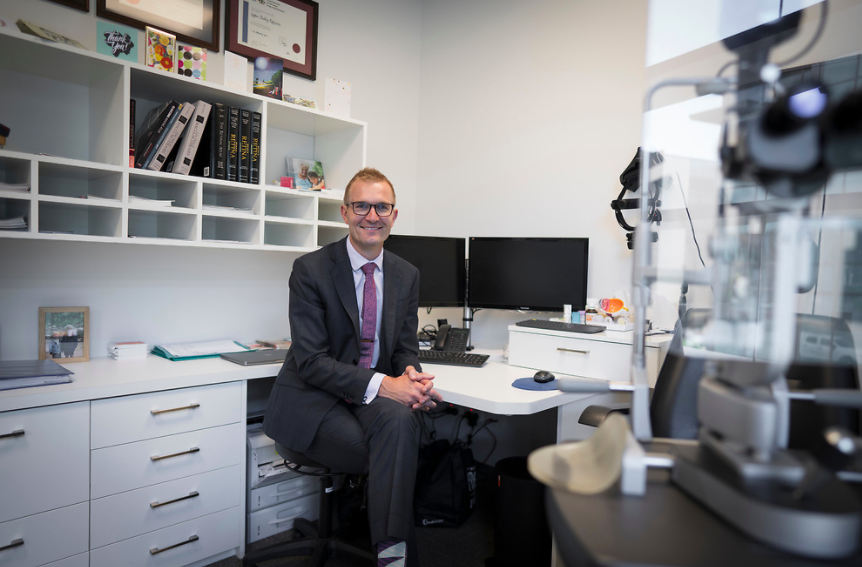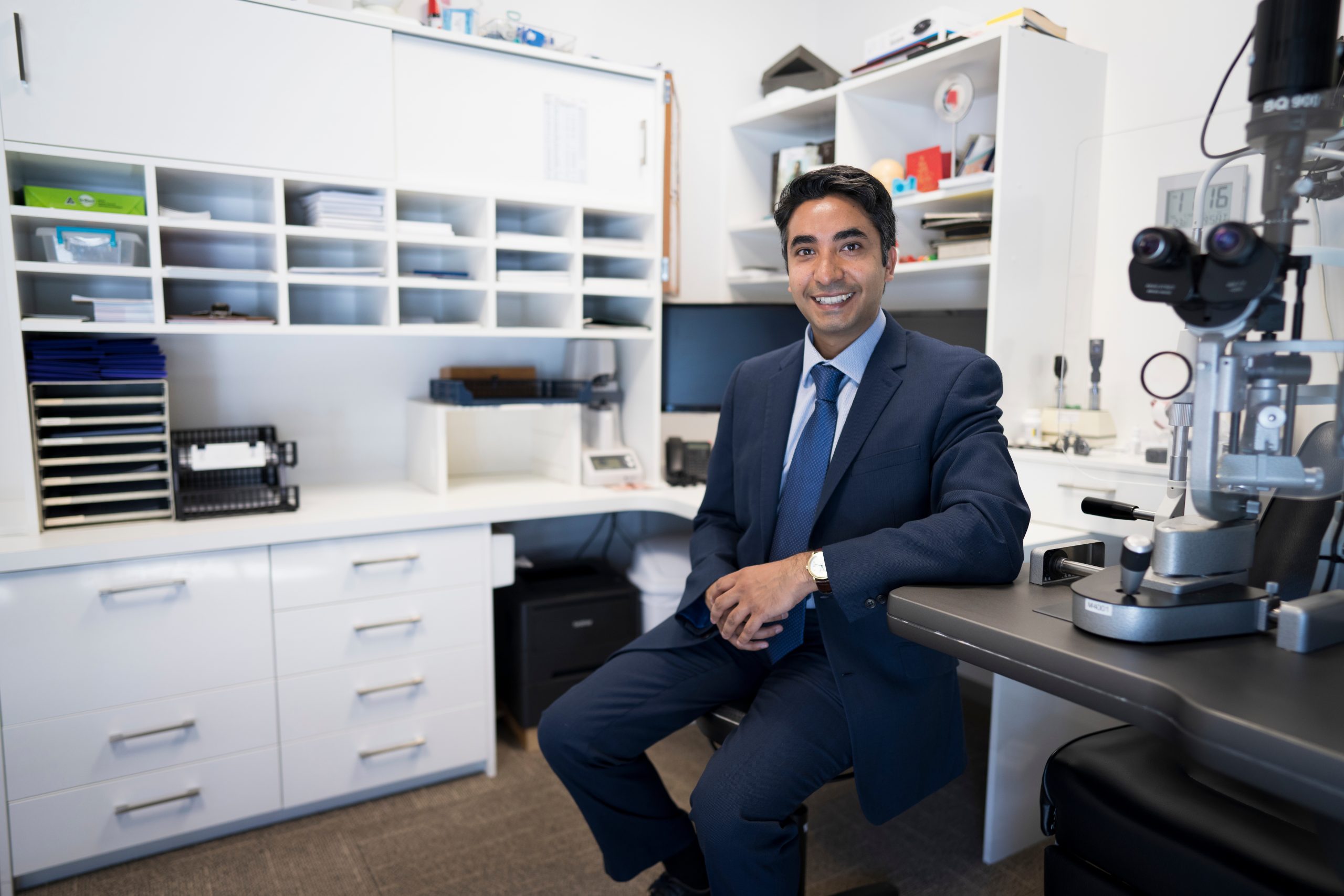Dr Robert Weatherhead
Oculoplastic & reconstructive surgeon
MB ChB, FRCS, FRACS, FRANZCO
With extensive and invaluable experience at major teaching hospitals overseas Dr Rob Weatherhead delivers the very best in care and capability to his patients at Southern Eye Specialists.
After beginning his journey in ophthalmology in Dunedin, where he earned his medical degree at the University of Otago, Rob continued his career in Australia, the United Kingdom, and the Middle East.
After considerable time working at some of the world’s most renowned hospitals he arrived back in New Zealand with prodigious experience and expertise in oculoplastic and reconstructive surgery.
The point of view
Dr Robert Weatherhead
After four decades in ophthalmology there’s not much Dr Robert Weatherhead hasn’t seen, particularly in his specialty areas of oculoplastic and reconstructive surgery. With extensive experience in international teaching hospitals, and a desire to stay at the cutting edge of technological developments he is truly a master in his field.
It was the lifestyle and flexibility for travel that initially attracted Rob to the medical profession. An adventurer at heart, the career decision resulted in years of travel around the globe, thousands of grateful patients, and hundreds of entertaining and incredible stories.
After completing medical school in Dunedin, with the final year in Wellington, he opted to do his “house jobs” in a large Brisbane hospital, where he “arrived with $20 in my pocket.”
Here, when seeing eye patients in the A&E department, his interest in ophthalmology was piqued.
“Registrars doing the College exams were based in that hospital, so I’d give them a call if I got anything interesting,” he says. “I got a lot of one-on-one teaching, which was certainly helpful and put me ahead of my peers.”
The desire to learn from the best continued to define Rob’s approach to medicine.
From Brisbane, he decided to pursue specialist ophthalmologic training in England.
After a short stint at the Kent County Eye and Ear Hospital he found his way to Kings College Hospital and then onto the prestigious Moorfields Eye Hospital in London.
After 18 months working in the outpatient clinics at Moorfields, he secured a place on the training scheme there. The scheme was renowned both for the level of training and the sheer hard work required from the Registrars. Far from a grind though, Rob found the experience fun.
“Moorfields had subspecialty clinics which we rotated through – retina, glaucoma, the lid clinic, the shingles clinic, the corneal clinic and so on,” he says. “You were learning stuff all the time.”
This shift to more focused clinics was set up by a fellow Kiwi, Professor Barrie Jones, and sought to mirror the sub-specialisations emerging in America. It marked one of many changes Rob witnessed in the field.
While in the UK, Rob managed to make the most of his six weeks annual leave to enjoy the lifestyle that first attracted him to medicine. He travelled most often to Greece in the summer, skied in the winter, and ventured further afield to the Caribbean. It was a time of travel, inspiration, and adrenaline.
Working in London also brought its share of jeopardy too. Rob was at Westminster Hospital during the IRA terror attacks of the early 1980s and holds visceral memories of tending to injured troops and civilians.
“The Horseguards bombing in particular – that was disastrous,” he says. “We were all hands to the pump.”
The city has changed a lot since then, as has the medical profession. One big change has been with the type of suturing.
“When I started, we were using thread made out of silk, nylon and catgut,” says Rob. “With the arrival of better needles and a host of synthetic materials for sutures, more precise wound closure was possible. The day of the horsehair suture was over.”
The introduction of the CT scanner was also game-changing for diagnosing and locating orbital and brain lesions. Then, with MRI development around ten years later, the standard changed once again.
“It was absolutely amazing,” he says. “You could see inside a tumour and what radiologic characteristics it had – the level of diagnostic accuracy was hugely improved.”
“Work in genetics was very basic when I was starting out in my career too,” Rob
says. “Now, huge advancements have been made in identifying genes involved
in pathology, molecular markers for conditions have been identified, and medicines developed based on the molecular pathways in the tumours.”
“The Dean’s secretary rang from Moorfields and said I was the only ophthalmologist available to take up the position. They wanted someone to go to Jeddah … and I had to get there by tomorrow. There’d be a ticket waiting at the airport.”
After a long flight, and now distant from his native Canterbury Plains, Rob found himself being processed through the Haj terminal at the airport in Jeddah.
“I arrived in the middle of Haj – there were a million people in the terminal. I’m not sure how I managed to find the driver but, amidst the crowds, hello, there’s a man holding up a sign with my name on it.”
A jet-lagged Rob figured he could cope with a hospital compound that featured a brand-new Olympic-sized swimming pool, and the sporting rivalry one of his old English squash mates heading up the hospital physiotherapy department.
Sport has often smoothed the transitions as Rob bounces around the world. Squash was his first love, which he picked up at Burnham Military Camp while his father was serving in the NZ Army. He played throughout medical school and later found it fitted perfectly with his London lifestyle and the local English weather.
“There was a phone outside the squash court door so I could be on-call, and could make it back in ten minutes to the hospital.”
As the initial one month contract in Jeddah turned into a year, and then a second and a third year, squash continued to feature heavily. There was lots of travel around the Saudi kingdom, and to Cairo and beyond for matches. Rob recalls that “some courts were open to the sky – they would get dusty, and we would have to sweep the floors before playing. Some did not have air-conditioning either.”
The love of travel and sports proved lucrative too.
“Tournaments were sponsored by the airlines, camera makers, electronic firms including Panasonic, and prestige watch makers,” he says. “One year playing squash, badminton, wind-surfing and five-a-side soccer I made more in my sponsorship and prizes than I did from my salary.”
Rob continued to play competitive squash when he returned to New Zealand, even playing in the World Masters.
But his time in the Middle East wasn’t all boasts, volleys, and squeaky shoes. Proximity to the Red Sea allowed many snorkelling and scuba diving trips with his ex-pat colleagues. And then there was the work, where his reputation was spreading.
An opportunity he couldn’t refuse presented in 1986 when the King Khalid Eye Hospital opened in Riyadh. Along with Bascom Palmer Eye Institute in Miami and Moorfields Eye Hospital in London, KKESH is one of the biggest eye hospitals in the world.
With a team of five oculoplastic specialists, KKESH attracted all the big names in ophthalmology from Russia, America, Britain, and Switzerland.
“Every major eye person would turn up to visit, lecture, and just to look at this place,’ says Rob. “Every Monday teaching Grand Round, there’d be a different international visitor.”
It wasn’t the plan to spend so long in the Middle East but, as Rob says, he “just got distracted”. It wasn’t just professional challenges and triumphs that would divert him from returning either.
In Riyadh, Rob met a Scottish medical secretary who would become his wife. They brought up three children in Riyadh and “basically spent 15 years trying to get back to New Zealand.”
Arriving back here in 1997, the consultant had become the teacher. Since then, he has spent a considerable amount of time teaching at Christchurch Hospital and has also served as an examiner in Oculoplastics for the Royal Australian and New Zealand College of Ophthalmologists (RANZCO) for 13 years.
Rob believes his career has followed a common pattern.
“The first ten years as a consultant you’re still learning how to practice ophthalmology. The second ten you’re researching and getting specialist knowledge from sub-specialty journal reading and from international colleagues at meetings – remember, this was before the internet for me. The third ten years is spent teaching and examining.”
This ability to spot talent and nurture the next generation in ophthalmology has been a major advantage for Southern Eye Specialists. Here, Rob has helped us grow from a team of three in a small clinic to a collection of experts operating within a purpose-built building.
Rob has also enjoyed time spent working on another precision field: his golf game. After coming to the sport late in life, he admits that “As a golfer, I’m as good as I’m going to get.”
“I’m naturally left-handed at golf, but learnt to play right-handed when my wife bought right-handed clubs (that were left untended when our children were growing).”
His patients certainly appreciate the skill in his hands, and Southern Eye Specialists is fortunate to have such expertise. Rob’s experience is truly invaluable to our team, and his warm and caring nature is of immeasurable worth to our work.
While he’s accomplished so much, the evergreen eye surgeon’s passion for life remains undiminished. With a twinkle in his eye and a smile always close, the future promises more adventures yet.
“The first ten years as a consultant you’re still learning how to practice ophthalmology. The second ten you’re researching and getting specialist knowledge…. the third ten years is spent teaching and examining.”

